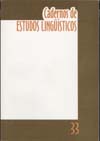Resumo
Argentine Sign Language or LSA is the primary means of interactive communication between the members of the deaf community. As every other sign language LSA lacks, up to the moment, a written register, all the communication being thus conversational. An important step in the analysis of a sign language must undertake the description of the interaction structure. Our main purpose is thus to present an analysis from an interactional perspective that may give a better account ofthis particular kind of interaction: deaf/deaf (Sacks, Schegloff and Jefferson, 1978). Such a view allows us also to examine sign language and its differences and similarities with interaction in spoken languages. On the other hand, it enables the deaf to better comprehend the use of their own sign language. Thus, the unit of analysis has been the interaction. The material under study consisted of 30 hours of video-recordings gathered throughout the seven years of research under different experimental conditions -prepared and spontaneous sessions-, and in different settings -home,
association. Three different registers have been observed: public, private and intimate. The main difference between them consisted in the use of space between the participants of the interaction, the non-manual features and in the production of certain adyacent pairs characteristic of each register. We have chosen to analyze the intimate register, that is to say, an interaction carried out by intimate friends or couples in different settings -association, home, for example-, and the different sign acts the deaf perform in order to show the differences and similarities with interaction in spoken languages.
Referências
GOFFMAN, E. (1981). Forms of Talk. Philadelphia, University of Pennsylvania Press.
HYMES, D. (1972). Directions in Sociolinguistics. Philadelphia, The University of Pennsylvania Press.
MASSONE, M.I. (1993). O lingüísta ouvinte frente a uma comunidade surda é ágrafa: Metodologia da investigacao. En : Moura, M.C., Lodi, A.C.B. and da C. Pereira, M.C. (eds.). Língua de Sinais e Educacao do Surdo. Vol 3. San Pablo, Sociedade Brasileira de Neuropsicologia, 72-93.
MASSONE, M.I. and Johnson, R.E. (1991). Kinship terms in Argentine Sign Language. Sign Language Studies 73: 347-360.
MENÉNDEZ, S.M. (1995). El análisis pragmático del discurso. En: Menéndez, S.M., (ed.). Análisis pragmático del discurso: perspectivas, métodos y alcances. Facultad de Filosofía y Letras, Universidad de Buenos Aires, Cuadernos de Lingüística Nº 1: 15.
SACKS, H., Schegloff, E. and Jefferson, G. (1974). A simplest systematics for the organization of turn-taking in conversation. Language 50 (4): 696- 733.
SPERBER, D. and Wilson, D. (1986). Relevance. Harvard, Harvard University Press.
ULLUA, E.S., Puccio, A.C. and Massone, M.I. (1996). Prisoners as a minority minorized by force and communion. SALSA IV Symposium about Language and Society-Austin, Texas (in press).
VERSCHUEREN, J. and BERTUCELLI, M. (eds.). (1987). The Pragmatic Perspective. Amsterdam, John Benjamins.
WILSON, J. (1989). On The Boundaries of Conversation. Oxford, Pergamon Press.
O periódico Cadernos de Estudos Linguísticos utiliza a licença do Creative Commons (CC), preservando assim, a integridade dos artigos em ambiente de acesso aberto.

